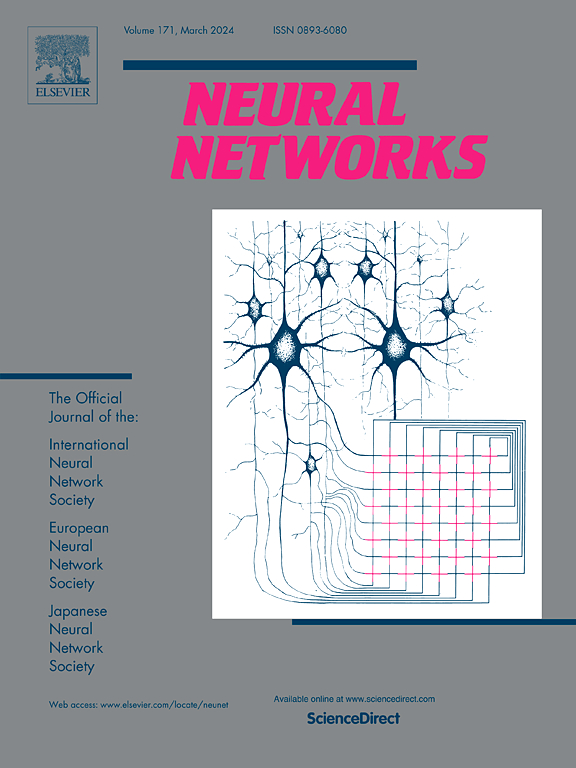SS-KAN: Self-supervised Kolmogorov-Arnold networks for limited data remote sensing semantic segmentation
IF 6.3
1区 计算机科学
Q1 COMPUTER SCIENCE, ARTIFICIAL INTELLIGENCE
引用次数: 0
Abstract
Self-supervised learning has emerged as a powerful approach for remote sensing image segmentation. However, its effectiveness significantly diminishes in remote sensing scenarios with extreme label scarcity (no more than 5 % of samples annotated). This limitation arises from two primary challenges: (i) insufficient exploitation of hierarchical representations in unlabeled data and (ii) irreversible information loss that occurs when adapting features from pretraining to downstream tasks. To tackle these challenges, this study proposes SS-KAN, an enhanced self-supervised learning framework based on the Kolmogorov-Arnold Network (KAN). The framework includes two key innovations: First, it features a depthwise KAN module, which combines depthwise separable convolutions with dilation rates and learnable activation functions within a multi-scale branch structure. This design enables the creation of context-aware feature representations from unlabeled images. Second, the framework develops a dual-branch adaptation strategy during the fine-tuning phase. This strategy utilizes a bifurcated structure that maintains spatial semantics through standard convolution while incorporating KAN-driven decomposable nonlinearity into residual identity mappings. As a result, it effectively enhances the hierarchical feature representation and reduces feature degradation during domain transfer, particularly in scenarios with limited data labels. Extensive experiments conducted on three benchmarks demonstrate that SS-KAN outperforms other state-of-the-art methods, even when trained with only 1 % labeled data. Ablation studies further confirm the importance of both the depthwise KAN and dual-branch adaptation modules. Our findings suggest that integrating KAN adaptive nonlinearity through learnable activation functions with depthwise convolutional operations and identity mappings opens new possibilities for data-efficient remote sensing image segmentation. Our code will be available from https://github.com/zhangjy2008327/SSKAN.
基于自监督Kolmogorov-Arnold网络的有限数据遥感语义分割
自监督学习已成为遥感图像分割的一种有效方法。然而,在标签极度稀缺(不超过5%的样本标注)的遥感情景下,其有效性显著降低。这种限制来自两个主要挑战:(i)未标记数据中分层表示的利用不足;(ii)在将特征从预训练调整到下游任务时发生的不可逆转的信息丢失。为了应对这些挑战,本研究提出了SS-KAN,一种基于Kolmogorov-Arnold网络(KAN)的增强自监督学习框架。该框架包括两个关键创新:首先,它具有深度KAN模块,该模块在多尺度分支结构中结合了具有膨胀率和可学习激活函数的深度可分离卷积。这种设计允许从未标记的图像中创建上下文感知的特征表示。其次,该框架在微调阶段制定了双分支适应策略。该策略利用一种分叉结构,通过标准卷积保持空间语义,同时将kan驱动的可分解非线性纳入残差恒等映射中。因此,它有效地增强了分层特征表示,并减少了域转移过程中的特征退化,特别是在数据标签有限的情况下。在三个基准测试上进行的大量实验表明,即使只使用1%的标记数据进行训练,SS-KAN也优于其他最先进的方法。消融研究进一步证实了深度KAN和双支路适应模块的重要性。我们的研究结果表明,通过可学习的激活函数与深度卷积操作和身份映射集成KAN自适应非线性,为数据高效的遥感图像分割开辟了新的可能性。我们的代码可以从https://github.com/zhangjy2008327/SSKAN获得。
本文章由计算机程序翻译,如有差异,请以英文原文为准。
求助全文
约1分钟内获得全文
求助全文
来源期刊

Neural Networks
工程技术-计算机:人工智能
CiteScore
13.90
自引率
7.70%
发文量
425
审稿时长
67 days
期刊介绍:
Neural Networks is a platform that aims to foster an international community of scholars and practitioners interested in neural networks, deep learning, and other approaches to artificial intelligence and machine learning. Our journal invites submissions covering various aspects of neural networks research, from computational neuroscience and cognitive modeling to mathematical analyses and engineering applications. By providing a forum for interdisciplinary discussions between biology and technology, we aim to encourage the development of biologically-inspired artificial intelligence.
 求助内容:
求助内容: 应助结果提醒方式:
应助结果提醒方式:


